All over Ireland, shuttered premises in villages, towns and cities provoke memories of businesses that passed through generations, with the family’s front room at the back, and their home upstairs. It was a time when people literally lived over their shops.
In addition to sites vacant before Covid-19 took hold – Census 2016 recorded the national vacancy rate as 13.5 per cent – there are countless commercial premises with shiny fit-outs that deflect attention from layers of upper-floor neglect. Others have lean-tos and modifications that can demean and even damage original building fabric. When there are more than a couple of such properties on a street they give off a gloomy air, and they deaden the area at night.
There is good news, such as some councils’ shopfront improvement schemes which also part-fund repairs of upper floors. But incentives to encourage investment that could bring lasting benefit to urban areas have had mixed success, and the expensive conversion process, which is complicated by more than planning requirements, can hinder property owners’ best intentions.
Upper floors were traditionally used for housing: they do not require infrastructure, they have connections to utilities and drainage, are close to shops, services and public transport
In 2018 architect Orla Hegarty, assistant professor at the school of architecture, planning and environmental policy at UCD, noted that “existing buildings are the most readily available, cheap, quick and sustainable source of housing in the short term”.
In her submission to the Joint Oireachtas Committee on Housing, Planning, Community and Local Government, which was scrutinising the Vacant Housing Refurbishment Bill 2017, she said that as the upper floors were traditionally used for housing: “they do not require infrastructure, they have connections to utilities and drainage, are close to shops, services and public transport”.
So why is it still so difficult to restore them to residential use?
Hegarty points out that the Bill, brought by Fianna Fáil, was broadly welcomed – including by ministers such as Darragh O’Brien, who is now Minister for Housing – but that “it died with the change of government”.
She says the Department of Housing brought in some minor planning exemptions, created a new charge if a property is vacant for two years, and “produced a guidance document for conversions that is useful for property owners”. But it did not address the need for regulatory change, she says, nor did it solve the persistent problems or give owners an incentive to convert vacant properties.
The Living City Initiative is a tax incentive scheme for special regeneration areas in Cork, Dublin, Galway, Kilkenny, Limerick and Waterford that enables owners of residential or commercial properties to claim tax relief on refurbishment or conversion works. The programme for government includes a commitment to “introduce a new scheme to expand and build on [this] to encourage infill development”.
Architect Douglas Carson of Carson and Crushell Architects in Ranelagh is well placed to detail the intricacies of the process. The practice has recently secured planning permission for a client to convert his property at 80 Capel Street, Dublin 1, from a massage parlour to a cafe with two apartments overhead. This is one step on a long journey for the protected structure, says Carson. The next stages require “a significant amount of extra work due to the nature of the property”. Permission was granted subject to further approval, which requires deep reserves of money, time, negotiation and expertise.
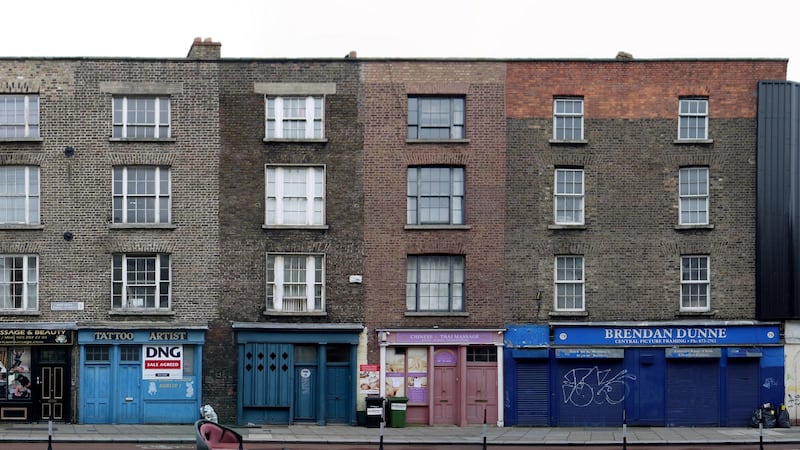
In general, these further approvals relate to conservation, access and fire safety processes, all of which involve more consultations, drawings and fees, in addition to addressing the planning conditions and compliance with building regulations. Each is the responsibility of a different council department, and there is no statutory timeline for the process.
And it is not without risk for the owner: if, for example, a local authority grants a fire safety certificate but some aspect of the project doesn’t meet the requirements of the conservation office, or if universal access cannot be facilitated, the project will fail and the permission will become void.
There is a risk, says Carson, that “Living City [Initiative] will become the preserve of wealthy people”; if legislation were streamlined from the top down, at State level, it would give local authorities clear guidance and they would no longer operate independent processes.
“In some cases the Heritage Council gives grants to fund repairs to protected structures, but they won’t cover the cost of installing new stairs or bathrooms, and they haven’t had a significant impact as they have to be carried out by specified contractors,” he says.
Living over the Shop, the predecessor of Living City, funded some conservation and restoration of this part of Capel Street in the mid-1990s. Number 80 is one of a terrace of six four-storey over-basement houses built in 1820-1825, and its particular shopfront and upper-floor windows make it unique on the street. The council’s conservation officer had some very specific requirements, for example, in relation to the staircase, that highlight the fine balance to be struck between conservation and modernisation. At early design stage, the proposal included three apartments but as there is just one staircase there are fire considerations.
This raises another contradiction; in upgrading the quality of the accommodation, fewer people are accommodated. Permission was granted for two one-bedroom apartments, which will probably lead to steeper rents: it is “the business of gentrification”, as Carson puts it.
In Use it or Lose it, an essay on conservation published by the Royal Institute of Architects of Ireland (RIAI), architect and former RIAI president Paul Keogh wrote that one of the issues is that our heritage protection policies need to be reviewed “in the context of the overarching policy objective to consolidate and regenerate the nation’s cities, towns and villages”.
“Buildings and places change over time – they must do if they are to survive as viable entities” and heritage protection guidelines “must include criteria for the management of that change; balancing historic values [conservation and restoration] with use values [social, economic and environmental sustainability]. The alternative is to let them fall into disuse and disrepair, along with the ensuing deterioration of their urban environments.”
Hegarty says there are local authorities willing to trial such conversions on an incremental scale; she gives the examples of “a bank building in a regional town that would have the same square footage as four three-bed, semi-detached houses, or a supermarket that has space for four apartments above it”.
She proposes a system of approval, control and enforcement in which property owners and their architects could consult with the councils’ conservation, fire and disability access officers so that they could submit a planning application with all of these considerations checked off, for a modest fee.
“It would work like an NCT,” she says, with everything verified independently afterwards. If the property were to be let out, this could tie in with Hap inspections.
Another obvious benefit is that there could be a mix of people in different sized units, bringing safety, diversity and community to town centres. And where ground-floor units are vacant, they could be repurposed as living spaces with universal access, and extra accommodation above.
In addition to providing good-quality, well-connected accommodation “on a human scale”, Hegarty says, prioritising and incentivising refurbishment of existing buildings over new-builds “would provide a pipeline of skilled, sustainable employment and apprenticeships to people in sectors of the construction industry that were decimated by the crash”.
She and Carson both highlight the European Heritage Award-winning refurbishment of 18 Ormond Quay Upper in Dublin 1, a merchant’s house built in 1843. It was undertaken and 90 per cent funded by the Dublin Civic Trust, with support from Dublin City Council and private donors.
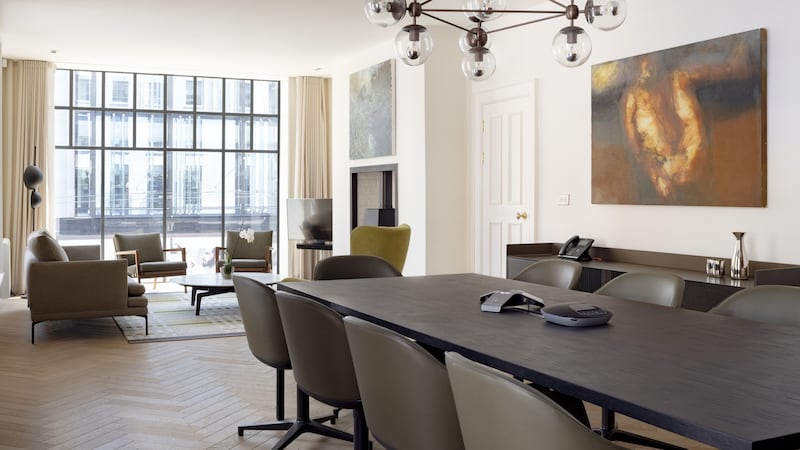
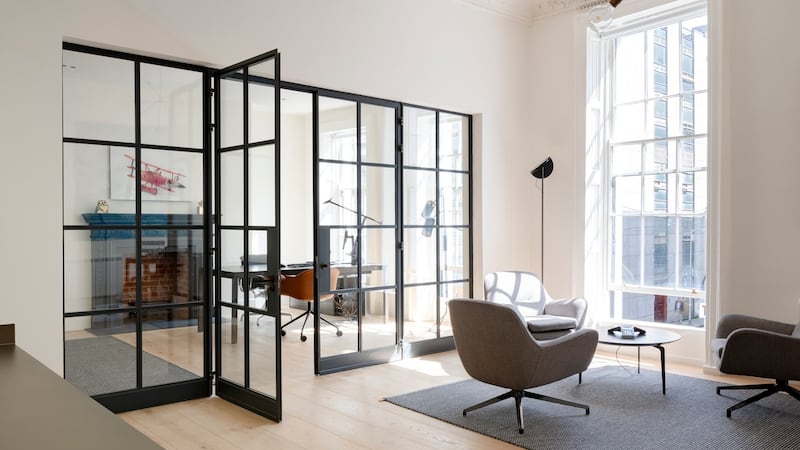
A close look at another award-winning project, the restoration and redevelopment of shop and office buildings at 51A, B and C Dawson Street, Dublin 2, shows the scale of the work involved in the conversion of a protected structure. The winner of the 2020 RIAI Architecture Award for adaptation and reuse exemplifies how architectural, engineering, conservation and planning professionals can collaborate to respect, protect and enhance a building’s original features within the constraints of regulations and fire safety.
The planning file includes method statements from contractors for the treatments of windows, window reveals, paint removal, repair of stairs, floors and ironwork and reports on, for example the degree of timber decay,
Number 51, as mentioned in the conservation architect’s report, is part of the 18th-century development of Dawson street (51A was built in the 1720s and 51B some decades later) as well as the 19th-century transformation of the street from residential to commercial. Different iterations of the internal layout included their amalgamation at first-floor level, including when it formed part of Tuthill’s hotel in the 19th century.
As per the conservation officer’s request, the conservation architect, project architect and engineers inspected and evaluated the fabric of the buildings in order to safeguard and renovate original features. New internal openings involved the removal of modern partitions, ceilings and joinery and, in fact, enabled the repair and damp-proofing of some original fabric that had been hidden. Interventions to improve fire safety, such as the installation of new doors between floors, were considered reasonable.
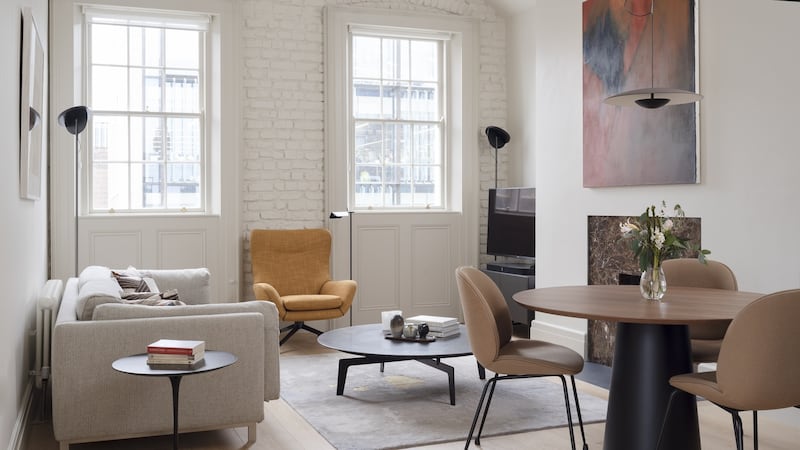
Such was the “ramshackle condition of the existing warren of sub-divided rooms”, as well as the minimal extent of heritage features to be conserved, that Paul Keogh Architects met no planning resistance to the contemporary interventions made in adapting the three buildings to their new uses.
“The planners allowed the floor levels to be evened out across the three houses; this larger floorplate enabled greater functionality and flexibility in the office layouts,” says Keogh. This is seen, for example, on the first floor where offices with handsome fireplaces and intricate ceiling plasterwork function as a grand space divided by a glass screen.
The restoration was not all about replacing like with like. At some point in the 20th century, the first-floor shop windows to Dawson Street were amalgamated. Rather than make a facsimile of the original facade, the design team retained this large opening and inserted a smart modern window, reflective of the restored sashes elsewhere.
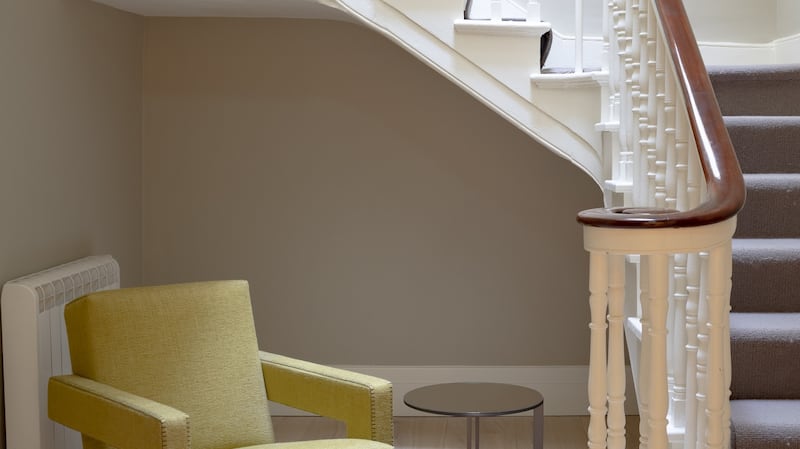
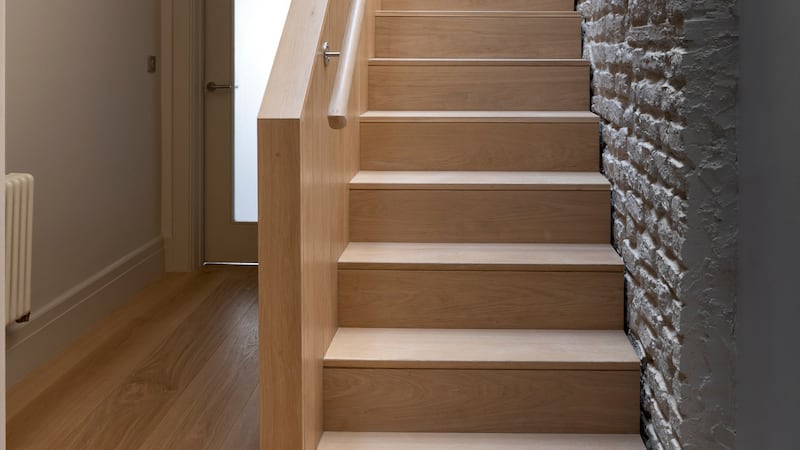
This frames the boardroom of FL Partners, the investment company that bought the building in 2016 in association with Rory McIlroy, whose management company offices occupy a floor above. Tenants include Greencoat and Biavest and, at ground floor, Butlers cafe, Featherblade restaurant and a Toni&Guy hair salon, all on long leases. Neill Hughes, one of the principals in FL Partners, is not exactly forthcoming about the scale of the money involved in the purchase and the restoration (the asking price for the 790sq m or 8,500sq ft property was €4.25 million), but he takes glowing pride in this “absolutely mixed development”.
On the second and third floors of the corner building is an apartment accessed from Duke Street, up a new staircase slotted into a void and lit by a large rooflight.
The apartment, like the rest of the interiors, was given a sleek and sympathetic finish by Elizabeth Kirby Designers, with bedroom and bathroom on the lower level and a kitchen and livingroom upstairs under a vaulted ceiling. This was Core engineers’ design solution to the condition of the roof in this section, says Keogh, “where rotten timbers were pushing out the walls”.
The upper stairs are set slightly proud of the exposed stone wall, the fire doors have incorporated glass (to comply with the fire regulations) and a screen of fireproof glass means the galley kitchen also benefits from the rooflight.
This project shows the potential that exists when there is collaboration and imagination; it’s slow, expensive and painstaking, but its benefits are far-reaching. Hegarty points out that when Irish people go abroad they often seek short lets that put them in the thick of local life. Perhaps legislative change and financial incentives will be key to repopulating Irish streets.













